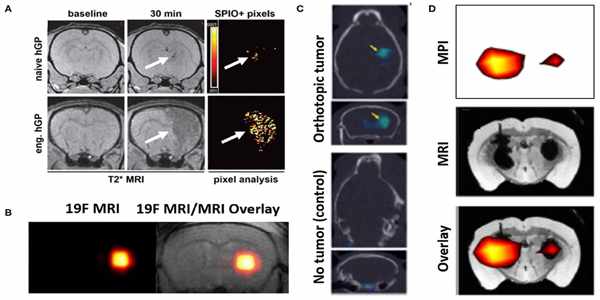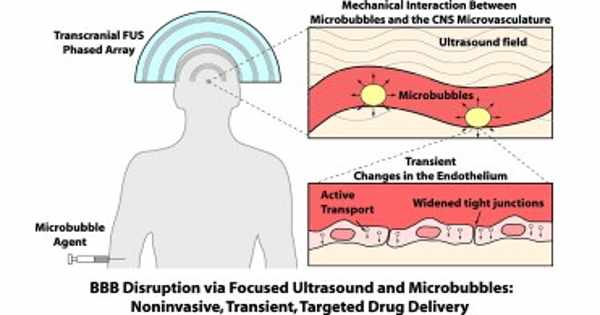The blood-brain barrier (BBB) is a semi-permeable structure in the CNS that controls the passive diffusion and active transport of solutes and nutrients between the compartments of blood and the brain. Although this structure is vital in brain homeostasis, it often hinders the reach of therapeutic concentrations in brain drug molecules and other chemicals. In conjunction with gas incubator injections, low-intensity focused ultrasound can reversibly damage BBB so that drugs can be delivered in the brain considerably.
MRI-guided concentrated ultrasound in combination with micro-bubbles can open the Blut brain barrier (BBB) and make it possible for medicinal products under the guidance of MRI to reach a diseased position in the brain. The technology is promising and has been demonstrated safely in patients with several brain illnesses including Alzheimer’s, Parkinson’s, ALS, and glioblastoma. MRI was employed in preclinical research and the clinical trial for treatments and evaluation, but until now researchers have not been aware of the impact on the BBB opening size and drug delivery efficiency of the static magnetic field created by the MRI scanner.
Hong Chen and her group at the University of Washington, St. Louis, in recent research in Radiology, found for the first time that the MRI scanner’s magnetic field decreased in a mouse model the BBB volume of opening by 3.3 times to 11.7 times, depending on the magnetic field intensity.
Researchers have found that the magnetic field of the MRI scanner decreased the BBB opening volume by 3.3-fold to 11.7-fold, depending on the strength of the magnetic field, in a mouse model.
In clinical investigations of the opening blood-brain barrier (BBB) in combination with MRI, a focused ultrasound mixed with micro-bubbles was used. In combination with micro bubble-medial blood-brain barrier opening, the static magnetic field of a RID scanner has been discovered to attenuate micro bubble cavitation and lower the focused ultrasound.
Chen and her lab carried out their investigation in 30 mice in four groups. They were an associate professor of biomedicine at McKelvey School of Engineering and Radiatory Oncology at the Medical School. After mice were injected with the micro-bubbles, the magnetic field had three focused-ultrasound groups: 1.5 T (teslas), 3 T, and 4.7 T, with a group never entering the magnetic field.
They found a dosage decrease of 2.1 decibels at 1.5 t and 2.9 dB at 3 t, or 3 decibels at 4.7 t in comparison with the dose that was received outside the magnet field. The dose of these two micro-bubbles was reduced at 1.5 t. The dose was 2.1 decibels at 3 T. The magnetic field also reduced the volume of the BBB opening to 1.5 T by 3.3, 3 T by 4.4, and the volume of the BBB to 11.7 T by 4.7. No tissue damage was observed by any of the animals from the operation.

The scientists injected Evans blue, a model medicine, after focused ultrasound sonography, to evaluate if the static magnetic field influences the efficiency of the trans-BBB medicines. In mice that received therapy in one of the three forces of magnetic areas compared with moice treated outside the magnet field, the fluorescence intensity of the Evans Blue showed that it was reduced. In comparison with individuals treated outside the magnetic field the Evans blue trans-BBB delivery was 1,4-fold at 1,5 T, 2,6-fold at 3,0 T and 1,9-times at 4,7 T.
MRI imaging (MRI) permits the control of the effects of ultrasound on brain structure and function not only to be more accurately targeted at brain regions and the result of sonication with regard to increased BBB Permeability. This review provides a summary of the current state of the art MRI hardware and methodologies employed in BBB opening protocols both pre-clinically and clinically.
“The damping effect of the magnetic field on the microbubble is probably caused by the loss of kinetic bubble energy due to the Lorentz force that acts on loaded molecules of the microbubble shell and the microbubbling water molecules,” says Yaoheng (Mack) Yang, Chen’s doctoral student, who was lead author of the study.
“Findings from this study imply that in the therapeutic uses of concentrated ultrasound in the administration of brain drugs the effect of the magnetic field must be considered,” says Chen.
In addition to the delivery of brain drugs, cavitation is also a basic physical mechanism for a number of other therapeutic procedures, such as histotripsia, cavitation, and sonothrombolysis, a treatment used after a high ischemical stroke, to mechanically destroy tissue areas. When using MRI-guidated focused-ultrasound systems, the damping effect caused by the magnetic field on cavitation is likely to impair the therapeutic results of other treatments mediated by cavitation.














